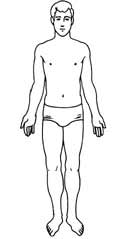Describe Anatomical Position.
It is the standard reference position of the body used to describe the location and inter-relationship of various parts and organs of the body. The body is in anatomical position when:
- Body is in upright standing position.
- Eyes are looking straight forward.
- Upper limbs are hanging by the sides and palms are facing forward with the fingers straight and together.
- Lower limbs are parallel (feet are together) and the toes are pointing forward

What are the Other Positions of the Body?
Supine position
- Person is lying on his/her back.
- Arms are by the sides.
- Palms facing upwards.
- Feet are together.

Prone position
Person lying horizontally with face down.
 Lithotomy position
Lithotomy position
Person lying on the back with the hips and knees flexed and the thighs apart. The position is often used for childbirth.
Describe the Various Anatomical Planes.
The major imaginary planes that pass through the body in anatomical position are
1. Median (mid-sagittal) plane: It is a vertical plane that passes longitudinally through the midline of the body and dividing it into equal right and left halves.
2. Sagittal plane: An imaginary vertical plane that is parallel to median plane and divides the body into unequal right and left parts.
3. Coronal plane: An imaginary vertical plane that is at right angle to the median plane and divides the body into anterior and posterior parts.
4. Transverse/ horizontal plane: An imaginary plane that divides the body into superior and inferior parts. It is perpendicular to the coronal and sagittal plane.
5. Oblique plane: A plane that divides the body at an angle between the horizontal and vertical planes.

Describe the Anatomical Terms Used to Describe Location & Interrelationship Between Structures?
Anatomical terms used to describe location and interrelationship between structures are:
Anterior (Ventral): Towards the front of the body (e.g. Sternum lies anterior to the heart).
Posterior (Dorsal): Towards the back of the body (e.g. Oesphagus is posterior to trachea).
Superior(Cephalic/Cranial) : Towards the head ( e.g. Heart lies superior to the diaphragm).
Inferior (Caudal): Towards the feet ( e.g. Mandible is inferior to maxilla).
Medial: Nearer to the median plane of the body (e.g. Nose is medial to eye).
Lateral: Further away from the median plane of the body (e.g. Lung lie lateral to the heart).
Proximal: Closer to the structure’s origin (e.g. Arm is prxomial to forearm).
Distal : Further away from the structure’s origin (e.g. Wrist is distal to forearm).
Unilateral : Structure present only on one side of the body (e.g. one upper limb).
Bilateral : structure present on both the sides of the body (e.g. both the upper limbs).
Ipsilateral: Structures present on the same side of the body(e.g. Right cerebral hemisphere and right arm are ipsilateral).
Contralateral: Structures present on the opposite sides of the body (e.g. Right cerebral hemisphere and left upper limb are contralateral).

<
Anatomical Terms Used to Describe Movements
Anatomical terms used to describe movements are:
• Flexion: It is bending of parts of the body in sagittal plane such that the two flexor surface come close to each other and the angle of the joint is decreased.
• Extension: The movement occurs in sagittal plane such that the angle of the joint increases.

• Adduction: The movement occurs in coronal plane such that the part of the body moves towards the median plane.
• Abduction: The movement occurs in coronal plane such that the body moves away from the median plane

• Circumduction: It is a combination of flexion, extension, abduction and adduction such that the distal end of the moving part moves in a circle.

- Medial rotation: is a rotational movement towards the midline.
- Lateral rotation: is a rotating movement away from the midline.

• Pronation: Medial rotation of forearm along with the hand such that the palm faces posteriorly. In semiflexed elbow, the palm faces downwards
• Supination: Lateral rotation of forearm along with the hand such that the palm faces anteriorly. In semiflexed elbow , the palm faces upwards.

• Inversion: It is the movement of foot in which sole faces inwards or medially.
• Eversion : It is the movement of foot in which sole faces outwards or laterally.

• Protraction: In this movement the part of the body moves forward.
• Retraction: In this movement the part of the body moves backwards such that from the protracted position is moves back to the anatomical position.

• Opposition: It is the movement of thumb such that the the tip of the thumb touches the tip of other digits.


THANKS>333
tremendously helpful
thank you for describing so nicely
this is a wonderful site ever I found well precise short notes. if only it could be organized to follow the topics of study… then it could be marvelous
Thanks. It means a lot.
Thank you sooo much…..I’ve been searching for this a lot…..you have made my day😀